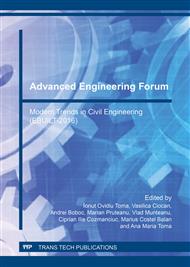[1]
G.D. Airey, A.C. Collop, N.H. Thom, Mechanical performance of asphalt mixturesincorporating slag and glass secondary aggregates, Proceedings of the 8th conference on asphalt pavements for Southern Africa (CAPSA'04), Sun City, South Africa, (2004).
Google Scholar
[2]
M. Arabani, S.M. Mirabdolazimi, Evaluation of the effect of the use of waste glass cullet in increasing the lifetime of HMA, 8th International congress on civil engineering, Iran, Shiraz University, (2009).
Google Scholar
[3]
M. Arabani, S.M. Mirabdolazimi, Investigation of the effective parameters on the fatigue behaviour of HMA containing waste glass cullet, Professional and practical congress of hot mix asphalt, University of Science and Technology, Iran, (2008).
Google Scholar
[4]
National Lime Association, Hydrated lime-more than just a filler, (2001).
Google Scholar
[5]
D. Maurer, M. Gerald, Field performance of fabrics and fibers to retard reflective cracking, TRR, (1989), pp.13-23.
Google Scholar
[6]
G. Aierey, A. Collop, S. Zoorob, C. Elliott, The influence of aggregates, filler and bitumen on asphalt mixture moisture damage, Construction and building materials, vol. 22, (2008) (9), p.2015-(2024).
DOI: 10.1016/j.conbuildmat.2007.07.009
Google Scholar
[7]
X. Chen, B. Huang, Evaluation of moisutre damage in hot mix asphalt using simple performance and superpave indirect tensile tests, Construction and building materials, vol. 22, (2008) (9), p.1950-(1962).
DOI: 10.1016/j.conbuildmat.2007.07.014
Google Scholar
[8]
M.L. Dragomir, C. Petit, Thermal shrinkage bending test in characterizing reinforcement advantages over bituminous mixtures, Acta Tehnica Napocensis Civil Engineering and Architecture, (2011), ISSN 1221-5848 Vol. 54, No. 1, pp.112-121.
Google Scholar
[9]
M.L. Dragomir, M. Iliescu, Analiza performanţei mixturilor armate cu dispozitivul de tracţiune-încovoiere, Simpozionul de comunicări ştiinţifice studenţeşti-secţiunea doctoranzi, mai (2011), ISSN 2247-2231.
Google Scholar
[10]
M.L. Dragomir, Studiul unor soluţii de ranforsare a structurilor rutiere suple şi semirigide, Teză de doctorat, Cluj-Napoca, (2012).
Google Scholar
[11]
S.M. Naş, Contribuţii la realizarea unei metodologii de stabilire a strategiei de întreţinere a reţelei de drumuri urbane, Teză de doctorat, Cluj-Napoca, (2005).
Google Scholar
[12]
R.L. Fitzgerlad, Novel applications of carbon fiber for hot mix asphalt reinforcement and carbon-carbon pre-forms, Master of science thesis, Department of chemical engineering, Michigan University of Technology, (2000).
Google Scholar
[13]
Y.R. Kim, Modeling of asphalt concrete, ASCE Press, (2009).
Google Scholar
[14]
E.A. Rahnama, A comparison on the performance of styrene-butadiene-styrene (SBS) polymer and textile fibers modifying asphalt concrete (AC), Master of Science thesis, Department of civil engineering, University of Science and Technology, Iran, (2009).
Google Scholar
[15]
S. Wu, Q.L. Ye, Investigation of rheological and fatigue properties of asphalt mixtures containing polyester fibers, Construction and building materials, vol. 22, (2008) (10), pp.2111-2115.
DOI: 10.1016/j.conbuildmat.2007.07.018
Google Scholar
[16]
G. Airey, Fundamental binder and practical mixture evaluation of polymer modified bituminous materials, International Journal of Pavement Engineering, (2004), vol. 5 (3), pp.137-151.
DOI: 10.1080/10298430412331314146
Google Scholar
[17]
Y. Yldirim, Polymer modified asphalt binders, Construction and building materials, vol. 21, (2007), pp.66-72.
Google Scholar
[18]
P. Peltonen, Wear and deformation of characteristics of fiber reinforced asphalt pavements, Construction and building materials, vol. 5, (1991), pp.18-22.
DOI: 10.1016/0950-0618(91)90027-i
Google Scholar
[19]
H. Chen, N. Li, C. Hu, Z. Zhang, Mechanical performance of fibers-reinforced asphalt mixture, Journal of Chan Univ., vol. 24 (2), (2004), pp.1-5.
Google Scholar
[20]
S. Tapkin, The effect of polypropylene fibers on asphalt performance, Building and environment, vol. 43, (2008), pp.1065-1071.
Google Scholar
[21]
F. Mohammad, H. Martin, Performance improvement of open-graded asphalt mixes, Department of mechanical engineering and applied mechanics, University of Rhode Island, Report no. URITC 00-44, (2002).
Google Scholar
[22]
A. Goel, A. Das, Emerging road materials and innovative, National Conference on materials and their application in civil engineering, India Hamipur, (2004).
Google Scholar
[23]
S.M. Abtahi, R. Khodadahi, S.M. Hejazi, E. Tavakkol, A feasibility study on the use of polypropilene fibers as a modifier in asphalt-concretes made from steel slag, 4th National Conference on bitumen and asphalt, Teheran, Iran, (2008).
Google Scholar
[24]
S. Tapkin, U. Usar, M. Tuncan, Repeated creep behavior of polypropylene fiber-reinforced bituminous mixtures, Journal of Transport Engineering, vol. 135 (4), (2009), pp.240-249.
DOI: 10.1061/(asce)0733-947x(2009)135:4(240)
Google Scholar
[25]
Information on www. fibre-polipropilenă. ro.
Google Scholar
[26]
J.P. Romualdi, G.B. Batson, Mechanics of crack arrest in concrete, Journal of Engineering Mechanics, (1963), p.28.
Google Scholar


